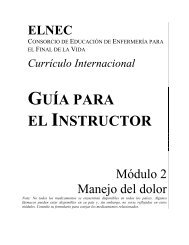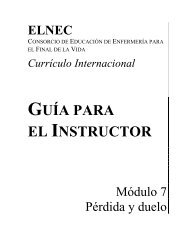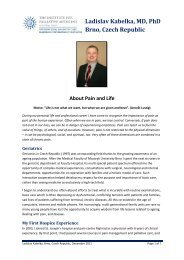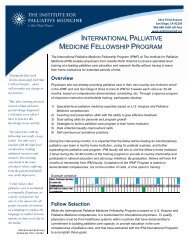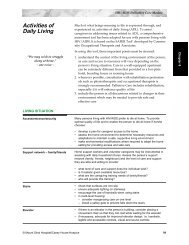17. Models of Palliative Care Delivery - IPCRC.NET
17. Models of Palliative Care Delivery - IPCRC.NET
17. Models of Palliative Care Delivery - IPCRC.NET
Create successful ePaper yourself
Turn your PDF publications into a flip-book with our unique Google optimized e-Paper software.
<strong>Models</strong> <strong>of</strong> <strong>Palliative</strong> <strong>Care</strong> <strong>Delivery</strong>CHALLENGES2. There are <strong>of</strong>ten fewer resourcesavailable in rural communities3. Persons living with HIV/AIDSmay live outside the localcommunity, resulting in longdistancetravel for designatedcaregivers. Other factorsinclude time, inclement weathersafety <strong>of</strong> the caregiver4. <strong>Care</strong>givers may have hadlimited exposure to HIV/AIDS,resulting in lack <strong>of</strong> HIV knowledge,discrimination and fearPOTENTIAL STRATEGIES2. Hospital and community based programs must develop servicescollaboratively. Prevent waste <strong>of</strong> unused supplies by establishingsystem to recycle supplies3. In some communities, it may be appropriate to develop regionalteams (both pr<strong>of</strong>essional and volunteer care teams) to most effectivelyservice outlying areas. To ensure the individual receivesrequired care as scheduled, and to ensure safety for staff andvolunteers, appropriate backup systems and supports must be builtinto community programs. These may include: use <strong>of</strong> cellularphones in caregivers’ cars, backup caregiver for each scheduledshift, 24-hour on-call system, etc.4. Additional to <strong>Palliative</strong> <strong>Care</strong> education, designation <strong>of</strong> an HIV/AIDS<strong>Palliative</strong> <strong>Care</strong> consultant is a useful support to caregiversCOMMUNITY CARECHALLENGE1. Many individuals living withHIV/AIDS receive care fromseveral caregivers and agenciesin the community. This canresult in fragmented and/oruncoordinated care, lack <strong>of</strong>communication, “splitting”, “turfwars”, and less-than-optimalservice to the individual2. Many community-based<strong>Palliative</strong> <strong>Care</strong> programs do notoperate 24 hours/day. This precludesmany people living withHIV/AIDS from staying at home1. Designate a coordinator to work collaboratively with the individual.This simplifies lines <strong>of</strong> communication for all involved, particularly theperson living with HIV/AIDS. The designated coordinator must beagreeable to the person living with HIV/AIDS and their role validatedby all members <strong>of</strong> the team. Some programs have developed enhancedcommunication tools which are left in the individual’s home foruse by the individual and caregiver. It is particularly important to coordinateassessment activities through “shared” documentation toeliminate duplication and unnecessary individual assessments. Whenscheduling caregivers, strive for consistency <strong>of</strong> caregivers whereverpossible. Regular team or teleconferencing meetings <strong>of</strong> the “careteam” are essential if interdisciplinary collaboration is to be achieved2. To permit the option <strong>of</strong> dying at home, community-based <strong>Palliative</strong><strong>Care</strong> programs must provide service 24 hours/day. Access to respitecare is essential to any community program. <strong>Palliative</strong> quick responseteams which respond to urgent needs may prevent unnecessaryhospital admissionsINSTITUTIONAL CARECHALLENGES1. Many <strong>Palliative</strong> <strong>Care</strong> units striveto create a home-like environmentwith greater emphasis onindividual autonomy2. Providing care in acute carehospitals is costly. An Americanstudy found the average per diemcost in acute care hospitals is$1,105.00 to $1,235.00Canadian dollars 11. Institutions which provide <strong>Palliative</strong> <strong>Care</strong> must strive to develop anatmosphere promoting individual autonomy, dignity and choice2. <strong>Models</strong> <strong>of</strong> care which demonstrate quality care and cost effectivenessshould receive funding priority144© Mount Sinai Hospital/Casey House Hospice




